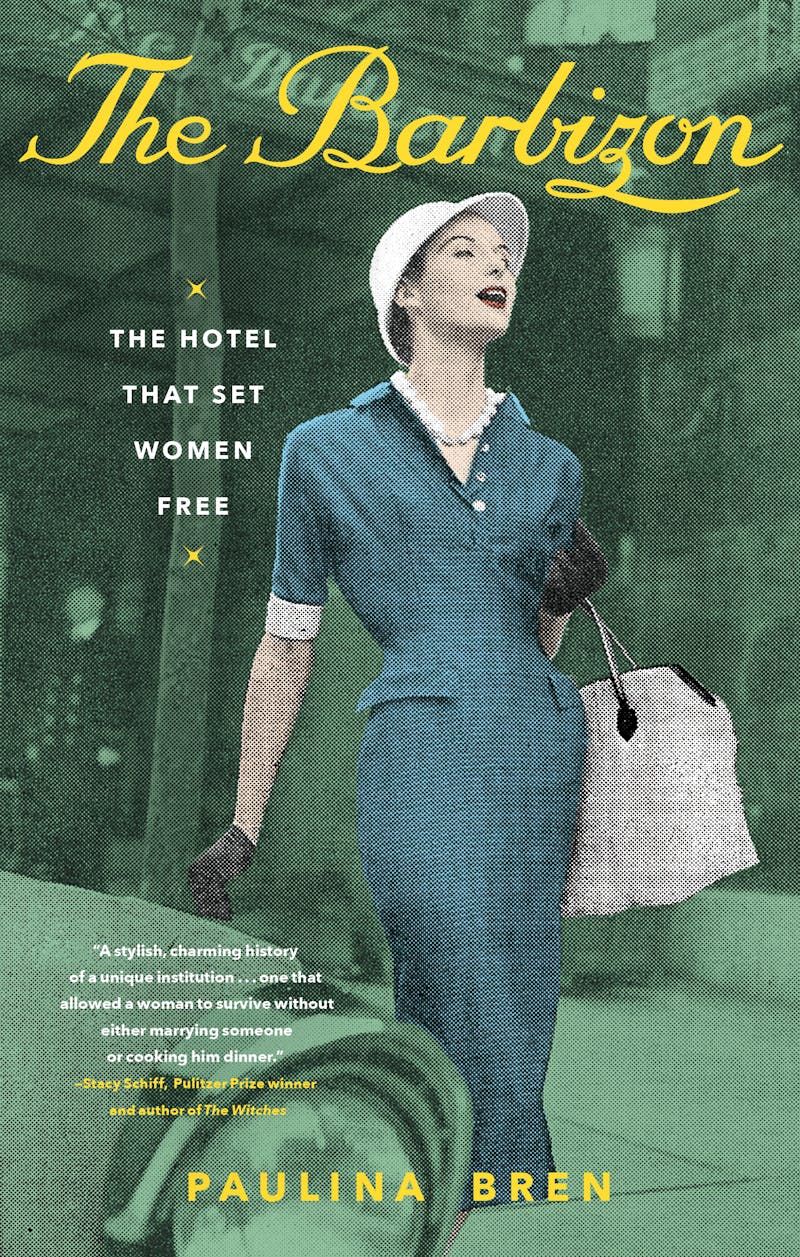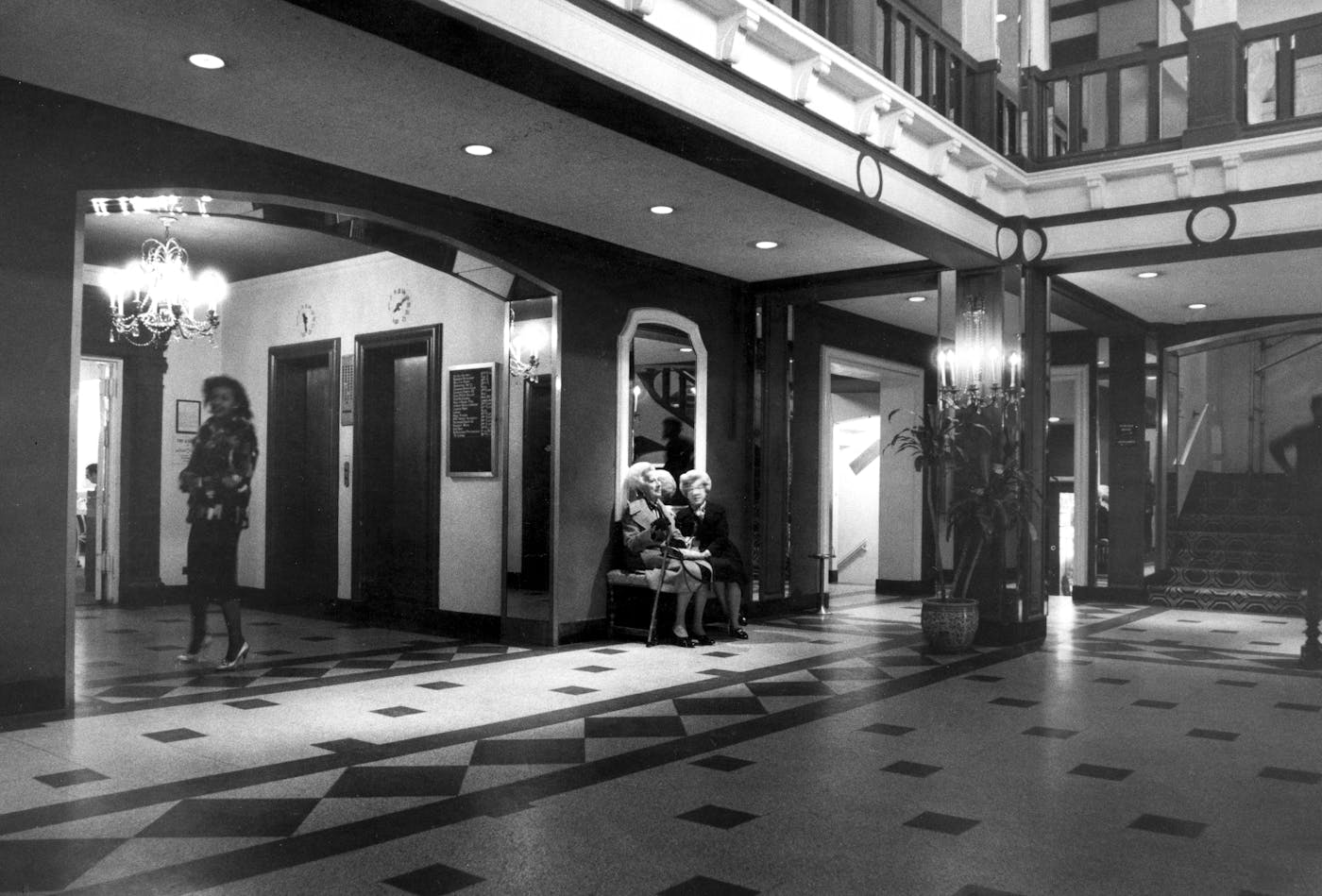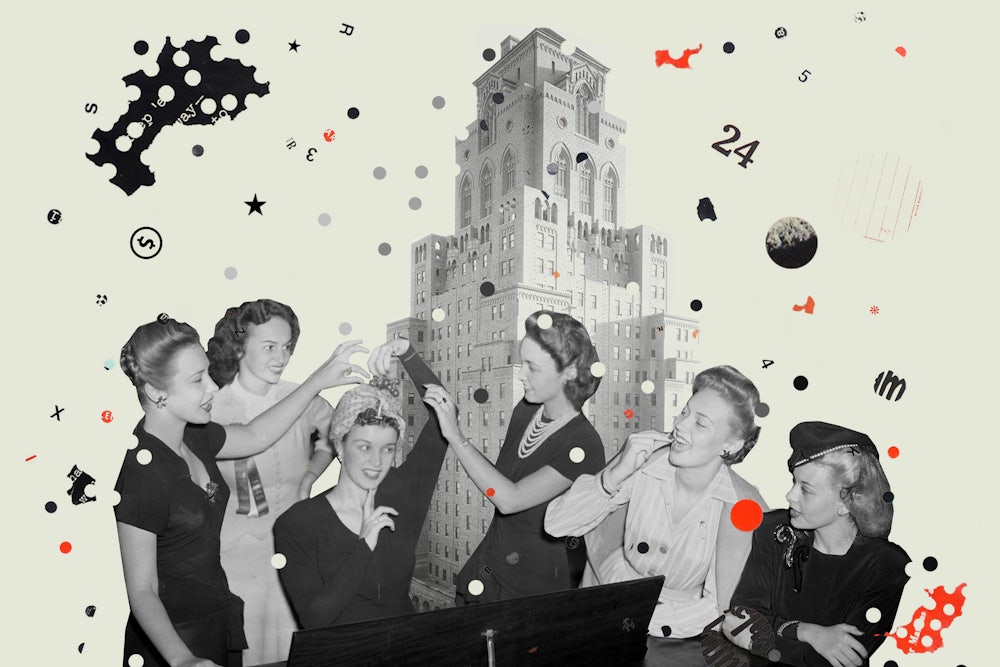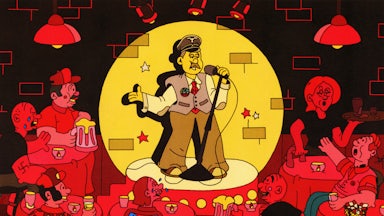On May 31, 1953, 20-year-old Sylvia Plath arrived in New York City. She was a rising senior at Smith College and already a published author, with three poems sold to Harper’s; she was also just a few months away from her first suicide attempt. Stepping off the train in Grand Central Terminal, she gained the attention of “two lovely muscular members of the US soldiery” who proceeded to help her with bags, escort her through the crowd, and travel with her in a taxi to her destination: the corner of Lexington Avenue and 63rd Street. For the first time in her life, Plath would be staying at a hotel—and not just any hotel, but the famous, glamorous Barbizon Hotel for Women. As one of Mademoiselle magazine’s 20 young “guest editors,” winners of a national contest for female college students, she would stay at the Barbizon for the next four weeks, at the reduced rate of $15 a week.

In a letter home to her mother, Plath described her “darlingest single” on the hotel’s fifteenth floor, with its “wall-to-wall rug, pale beige walls, dark green bedspread with rose-pattern ruffle, matching curtains, a desk, bureau, closet and white enameled bowl growing like a convenient mushroom from the wall.” There was a telephone in her room, and a radio, and she had a striking view of the United Nations building and the East River. The room was small, to be sure, but it was private, furnished, and entirely hers. Like many young women before her, and like many young women since, Plath thrilled to the idea of spending the summer in the city where anything could happen.
The Barbizon offered Plath and women like her a sanctuary in a bustling, sometimes overwhelming city, even as it also gave them a taste of an independent life. In an era when opportunities for women were limited, it “set them free,” in the words of historian Paulina Bren. In The Barbizon: The Hotel That Set Women Free, the first history of the hotel and the ambitious women who stayed there, Bren describes the Barbizon as “the go-to destination for young women from all over the country determined to give their New York dreams a shot.” Named after the Barbizon School of French painting, the hotel was known, particularly, for serving the female creative class. Barbizon women included the actresses Joan Crawford, Grace Kelly, and Liza Minnelli; the writers Plath, Joan Didion, and Meg Wolitzer; and the designer Betsey Johnson. From its opening in 1928 until its conversion to condos in 2007, the hotel hosted many a young woman who “had made her escape from her hometown and all the expectations (or none) that came with it,” and who was now ready to “remake herself” in New York.
Bren describes the women who made this journey as “women in between,” neither working-class nor upper-class. They were also living between different waves of feminism: the movement for women’s suffrage, which culminated in 1920, and the women’s liberation movement of the 1960s and 1970s. This was a particularly contradictory time for American women, during which they were empowered by increasing access to education but constricted by regressive gender norms that took on new life during the Cold War. Bren describes mid-century women as belonging to a “tightrope” generation. As one of Plath’s fellow guest editors, who also spent the summer of 1953 at the Barbizon, later put it, “we were the first generation after the war and the last generation before the Pill.” They could contribute to the country’s economic growth—as factory workers, secretaries, and homemakers—but could not yet control their own bodies. The hotel exemplified these contradictions: In the best cases, the Barbizon was the launchpad Bren describes; in others, it was a trap.
Bren begins her history with a figure of female freedom: the “New Woman,” a turn-of-the-twentieth-century character, the woman who wanted more. The New Woman wore bloomers, rode a bicycle, and agitated for the right to vote. The Gibson girl, with her voluminous hair, was one version of the New Woman; she was succeeded by the flapper, a short-haired woman with a cigarette in one hand and a drink in another. No longer content with being confined to the home, these women were out in the world, working, spending—and sometimes even having sex.
The Barbizon, one of several all-women hotels that were built in New York in the early twentieth century, arose to meet the New Woman’s needs. The “unsinkable” Molly Brown—suffragette, activist, and survivor of the Titanic shipwreck—was an early guest, staying there in 1931. The Barbizon was an ornate building, a “Romanesque sort of Gothic,” as one publication put it, with four turrets, a solarium, and rooftop gardens. For $10 a week, a woman could have her own room as well as access to the hotel’s shared spaces: lecture rooms, a gym, an elegant dining room, a library with oak-paneled walls, and soundproofed studios for music practice. There was even a pool in the basement. “Modern amazons in the making are learning to fence,” reported The New York Times. “Swimmers of the future are learning to crawl in the nether regions of the Barbizon.” Women were people, it turned out, and they needed space to stretch both their bodies and their minds.
The Barbizon was known for its exclusivity: Any guest had to come prepared with letters of reference, attesting to her character. (As Bren notes, this policy also served to keep the hotel racially and economically exclusive, though the Barbizon never openly stipulated that a guest must be well-off or white.) There were plenty of post–check-in policies, too, though fewer than one might find in comparable women’s hotels: no liquor or men in rooms, and not too many late nights out. (In the evenings, female elevator operators replaced the male operators who worked during the day.) On Saturday nights—designated “date night”—older, long-term residents known as “the Women” would watch the younger residents primp and would make unsolicited suggestions: Are you sure you want to wear heels that high? And a skirt that short?
As these rules, policies, and exclusions suggest, the freedom women found at the Barbizon had its limits. Bren argues that, in this era, the hotel became a haven for wage-earning women, and in many ways it was. During the Great Depression, when so many men found themselves out of work, working women were lambasted for “taking jobs from men”; in 26 states, it was illegal for married women to work at all. Although the Barbizon housed women who were actively pursuing employment, their options were limited to traditionally female jobs. All the women admitted to the famous Katharine Gibbs Secretarial School lived on the sixteenth and seventeenth floors of the Barbizon. Many models and aspiring models stayed at the hotel. Grace Kelly, the actress and future princess of Monaco, who came to the Barbizon to study acting in New York, ended up signing with Powers Models, after being rejected by Ford for having “too much meat on the bones.” (Eileen Ford, who ran the agency, later admitted that this was a huge mistake.)
By the 1940s, the working woman’s prospects widened, and the next two decades were maybe the Barbizon’s heyday—a moment when it seemed to offer women experiences unavailable to their mothers’ generation. “Young women during World War II were being told they could do anything they put their minds to,” Bren writes, as long as they were putting their minds to productive, patriotic purposes. Women were encouraged to take their educations as seriously as they took finding the perfect back-to-school skirt. Mademoiselle magazine, run by the imposing Betsy Talbot Blackwell (or “BTB,” as Bren calls her), became a success by catering to the college set. The magazine “for Smart Young Women,” as its tagline read, Mademoiselle combined “the frivolous with the serious”: One representative cover advertised both fashions “for spring, for brides, for tall girls” and the late Dylan Thomas’s verse play Under Milk Wood. The magazine published Edward Albee, Truman Capote, and Flannery O’Connor, as well as fiction by young women.
Bren dwells on Mademoiselle, particularly its mid-century years, in part because this was when the hotel hosted some of its most famous guests, all associated with the guest editor program: Plath, Didion, Janet Burroway, and Diane Johnson, to name a few. (Mademoiselle also introduced racial diversity into what is otherwise a very white story: In 1956, the magazine selected a Black dancer and visual artist named Barbara Chase, a student at Temple University, as one of the summer’s guest editors. Chase was very likely the first Black resident of the Barbizon.) The gig was an exciting opportunity for the aspiring writer or journalist, but it could also prove confusing: Guest editors were usually given menial tasks, often in the fashion and advertising departments, rather than the intellectual and literary work they had anticipated. They were photographed frequently and were supposed to model for the annual College Issue. As Bren writes, guest editors “would ask themselves: Was their real job to pose for photographers and detail their tastes and desires to a bevy of merchandisers and advertisers keen to know what America’s college girls wanted?”

The most poignant and intriguing parts of Bren’s book are the stories of women who made it to the Barbizon but failed to “make it” on mid-century America’s terms. The writer Gael Greene, a former guest editor, called them the “Lone Women” in a piece she reported for the New York Post in 1957. Arriving at the Barbizon with big dreams, these women failed to find the right job or the right guy. They were lonely, homesick, and occasionally desperate. Greene reported rumors of a woman breaking down in her room and smashing objects against the wall; other women came to gawk, but not to help. Some of Bren’s interviewees commented on the contradictions of the era, on the secret lives that swirled beneath the culture’s homogeneous surface. There were rumors of abortions, illegal in the 1950s and 1960s, as was contraception for single women in New York until 1965. During this same time, at least three women took their own lives at the Barbizon; the hotel did its best to cover up the suicides, so as not to deter future guests.
Despite her book’s title, Bren acknowledges that the single woman’s hotel room represented “some sort of liberation,” rather than liberation tout court. Young women might work, dine out, and date, but this was all seen as “an acceptable form of training for married life.” The Barbizon brought curious young women into the very center of American cultural production—they were walking distance from Broadway and Madison Avenue—but it didn’t do much to change that culture. The Barbizon offered women independence, and it surveilled them; it liberated them, and it protected them; it brought them together, and it pitted them against one another.
The women’s liberation movement was the beginning of the end for the Barbizon. In 1963, the year Betty Friedan published The Feminine Mystique, The Saturday Evening Post reported that the hotel’s clientele was changing. No longer all young dolls, guests included a “band of aristocratic 70 year olds and one aged 80; a Playboy bunny; a perennial candidate for New York State office; a stunt girl … and one fashionable merchandising student who shall be memorable for her name alone—Lady Greenslit.” As the world began to open up for women, some wondered whether women’s hotels were still necessary. By 1970, the year that women struck for equality across the country, the Barbizon looked outmoded and unappealing. In the words of one former guest, “I don’t know why girls interested in meeting men and having a life of their own would ever choose to live in a place like that.”
The hotel fought to stay single-sex at a time when the law required many institutions to go coed. It won its legal battle, but its occupancy rates fell precipitously. The Gibbs school moved out in 1972, leaving multiple floors of the hotel newly unoccupied. The occupancy rate dropped as low as 40 percent, and the hotel fell into disrepair. The consultant David Teitelbaum was brought on to help the hotel remake itself. He suggested that the Barbizon needed a full makeover: It needed to become hipper, glitzier—and it needed to go coed. The book’s final chapter tracks the renovations and reincarnation of the Barbizon in the last decades of the twentieth century; in Bren’s account, these changes satisfied almost no one, and it was no surprise that the hotel was converted to condos in the early twenty-first century.
How is it that a hotel that supposedly “set women free” was felled by women’s liberation? Although Bren emphasizes the intimate nature of the Barbizon—women living together, sharing hopes for the future, and brushing past one another in the lobby—it was not the kind of place that fostered solidarity. The focus was on individual achievement. In Bren’s story, there are “powerful career women,” such as Talbot and Mademoiselle managing editor Cyrilly Abels. And there are feelings of “empowerment,” perhaps best articulated by the actress Ali MacGraw, who stayed at the Barbizon in 1958, and who felt she was “going somewhere” just by virtue of staying there. Over 350,000 women stayed at the Barbizon through the mid-1960s, and though they may have bragged about their address on business cards and to prospective employers, they did not necessarily see themselves as part of a community, let alone a class.
Bren claims the residents networked, but much of that networking was done with men. In a representative story, a dancer after class at Juilliard stopped off at the hotel, where the composer Gian Carlo Menotti spotted her and offered her a job on the spot. Just as often as they helped one another, the women competed with one another, knowing how few spots were open to secretaries, and how few eligible men were in New York City. Even the woman who ended up a success—the secretary turned model, the actress turned princess—didn’t change her basic relationship to the power structure of America. She remained employee and consumer, a woman whose power lay mainly in her purse.
There’s an exception to this story, and it’s the one instance of real solidarity in Bren’s book. In 1975, when Teitelbaum was hired to help improve the Barbizon, he decided that the hotel needed to do something about “the Women,” the “lobby sitters in curlers and slippers” who were long-term residents of the hotel and had no plans to leave. The Women were largely seen as nuisances and failures. They were walking warnings to the younger residents: This is what could happen to you if you don’t find a man quick!
When Teitelbaum decided to take the hotel coed, the Women objected. They formed a tenants’ association and hired a lawyer. Teitelbaum offered the Women $1 million to leave, but the Women rejected the offer, saying they would take $10 million or a new apartment building, where they could pay the same price for the rooms they were renting now: an average of $275 a month. Under New York law, the Barbizon rooms were technically SROs, which meant they were subject to rent control, and the Women could not be evicted. The two sides eventually reached an agreement: During renovations, the hotel would build a new wing of rooms just for the Women. When the gaudy new hotel opened, guests would occasionally see an older woman open a secret door and enter a narrow hallway lined with small rooms, a replica of the hotel’s past. When the hotel went condo, the Women stayed put. Many of the 21 remaining women moved to the fourth floor, which was exclusive to the Women, and those who refused to move had their rooms updated anyway, though they continued to pay the same price they had when they’d first arrived in New York. Five of the Women live there today, sharing an address with celebrities like Ricky Gervais.
Perhaps this is just the perspective of someone renting in the third most expensive city in America, but I was riveted by the story of the Women. I wanted to know more: Who started the organizing? How did they convert people to the cause? How did they protect the most vulnerable members of their group? Their story reminded me of the tenants’ unions and rent strikes that are currently active in New York City, as the pandemic puts many renters in precarious positions. Like the Women, these tenant associations work to build enough power so that they can win protection from rent hikes and evictions. This kind of housing stability is itself a form of freedom.
Bren notes that the five Women who remain at the Barbizon “are not a tight group.” They don’t take tea together in the afternoons; they don’t knock on one another’s doors at night. But they came together when it mattered, and they protected one another from a ruthless ruling class. Their story isn’t a glamorous one: It’s not a whirlwind romance, or a story of being “discovered” while walking down the street (though there are plenty of stories like this in the book). It’s instead the story of the kind of slow, hard work that, when done collectively, wins new freedoms and brings about real change.
One of the last images in the book shows two older women exiting the Barbizon in 1980, just before the hotel went coed. The photograph echoes the book’s cover image, which shows a young woman in pearls and a tight-waisted dress, burdened with a heavy handbag, walking by the Barbizon’s entrance. Her mouth is open in awe; her eyes are half-shut, as if she can’t take in all that the city offers her. In this second image, one older woman, clad in a checkered shirt, pauses outside the hotel entrance, as if waiting for a taxi. The other, gray-haired and bespectacled, wearing a tea-length skirt and a light, cross-body bag, strides forth purposefully. She looks unawed and unafraid, as if she knows just what she’s doing. Alone, but close to others like her, she looks finally free.








